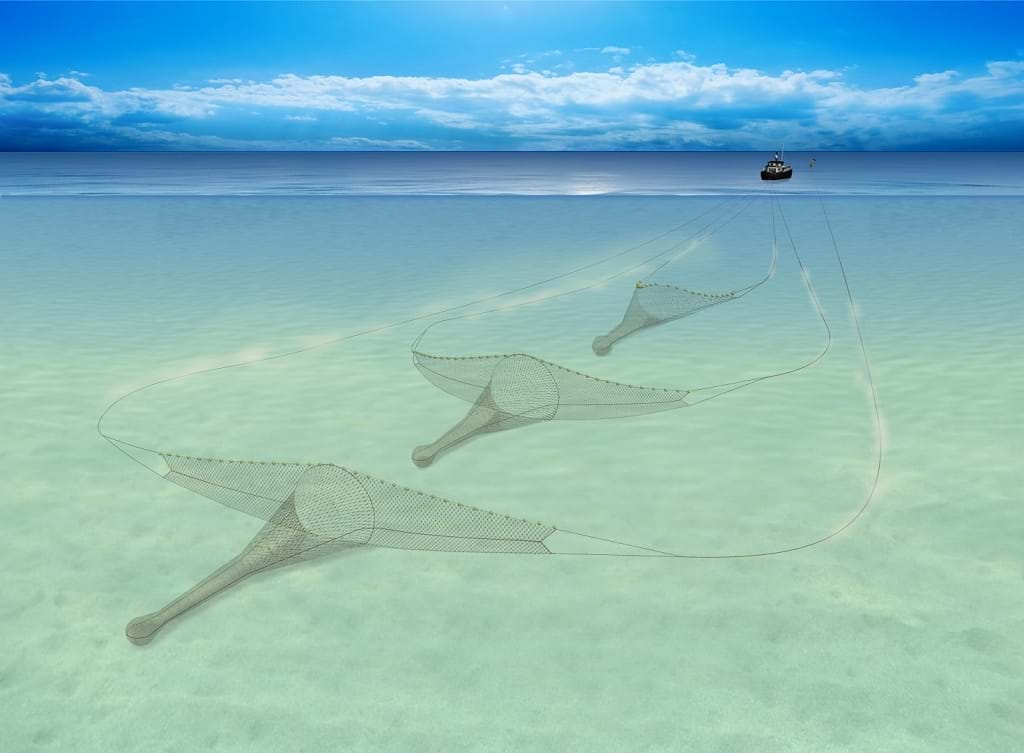SSC - Scottish Seine
Alternative names
-
- Fly Dragging
Summary
In the Scottish seine the gear is shot on the seabed in a rounded triangle shape with very long weighted ropes attached to each end of the net. The net is gradually hauled in with the vessel maintaining station using its engine power rather than an anchor as in anchor seining.

Environmental impact
Scottish seine net is accepted as a very environmentally method of fishing. The gear is only suitable for fishing on smooth sandy or muddy usually quite mobile sea beds. It cannot be operated on hard rocky sea beds as the gear would get damaged too easily. The gear consist of a lightly made net usually with only a rope footrope often called a ‘grass rope’. This is fixed to the fishing line of the net in bights with two or three lead rings threaded on the bight. The lead rings and bight of soft rope are the only contact with the seabed, the actual net skimming a few inches above the seabed therefore minimal seabed impact. The light contact of the rope bights on the seabed is enough to prevent the fish escaping underneath the footrope. many of the modern seine nets have a lightweight rubber leg footrope fitted to them to make them more robust for working hard sand sea beds.
The net is towed by long lengths of leaded rope that are laid on the seabed, these are towed over the seabed with a lot of tension in them therefore are very light on the seabed, just scuffing enough to create a light sand cloud to herd the fish into the net.
As the net is never really towed long, there is not much energy needed in hauling the gear. The gear can be operated from lower powered vessels with lower fuel consumption. Selectivity can by managed by usual means in towed gears such as mesh size and square mesh panels etc.
Other information
Scottish seine is a very skilful operation requiring extensive knowledge in locating fish within the grounds, accurate rigging of the gear, and consideration of tidal streams in relation to the gear throughout the shooting, towing and hauling operation. The modern seine net vessel can work anything up to 14 coils of rope each side of the net. Each coil consists of 220 metres (120 fathoms) of lead cored, abrasion resistant rope, from 19mm up to 32mm diameter depending on the size of vessel. One end of the ropes is shot, with a dhan (buoy) attached. The vessel then steams round in a circular shaped course shooting one side of the ropes, one end of the net is attached to the ropes and the net shot away half way round the circle.
On the other side, the ropes are attached to the other end of the net and they too are shot away with the vessel completing the circle close to the dhan, picking it up, leading both ropes to the winch and starting to ‘tow’ the gear. The vessel will tow until strain is on both ropes, then engage the winch to begin heaving slowly. At this stage the vessel is moving slowly ahead, the winch is used to haul the seine net ropes in, slowly at first, and speeding up as the gear is closed up. As the ropes are hauled in, the vessel will gradually start to be hauled astern towards the net even although the engine is still trying to drive the boat ahead. Once most of the ropes are hauled in, the gear is almost closed up and the net is hauled to the stern of the vessel, hauled on board and the cod-end emptied on the side deck of the boat or nowadays into a reception hopper. The gear is ready to be shot away again, and the skipper will take about an hour and a half to three hours.
The efficiency of seine net very much depends on the skipper’s experience and ability to keep the gear square and to get the speed of hauling correct at the various stages, taking into account the weather, the tidal conditions, the behaviour of target species and the depth of water. At one time (1950s to 60s), Scottish seine net was probably the main fishing method in Scotland for demersal fish. At this time, there would have been only a handful of vessels in England using the method; anchor seining was still their favoured method.
Over the years, many vessels have changed to trawling, and up to year 2000 there would have been only a few vessels left using Scottish seine in the UK. However, in recent years, there has been a small resurgence in seine netting, with a few new vessels being built specifically for this method of fishing. This is probably because seine netting is a very fuel efficient method of fishing, and it gives the skipper the opportunity to land fish to the market in prime condition, thereby securing top prices on the market. The main areas of operation in the UK are North and North East Scotland, and Shetland, but only by a few vessels. Over the years, many Scottish vessels have turned to pair seining.
Documents
-
Advances in Seine net fishing 1965-2008
-
International Workshop on Seine Net Fishing
-
Selectivity Trials using Square Mesh Panels in a Scottish Seine - Preliminary Sea Trials MFV Kiloran EC Funded Project TE 2-411
-
Selectivity Trials of Seine Net Codends - MFV 'KESTREL' (INS 253) - April 1990
Gear classification
Main target species (UK)
-
- Any demersal species
- Cod
- Flats
- Haddock
- Hake
- Lemon Sole
- Monkfish
- Plaice
- Whiting
Possible bycatch
-
- Any demersal species
- Immature round fish
- Juveniles of the target species